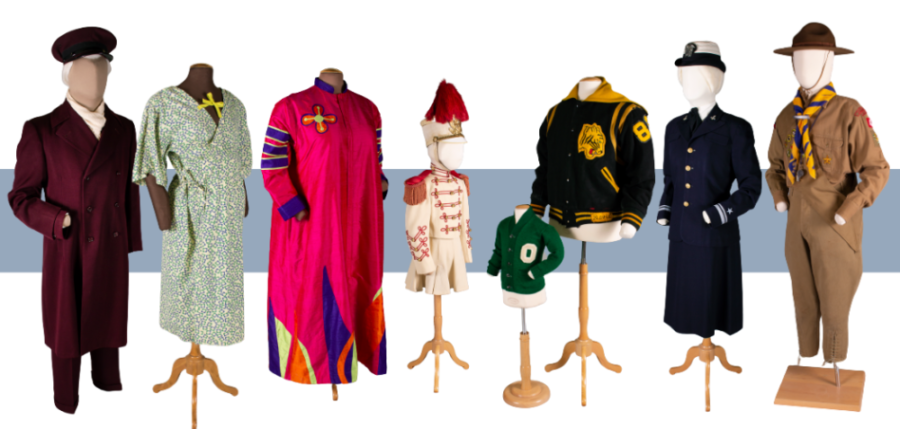“Dressed for the Job”: The clothes that built Cleveland
Courtesy of the Western Reserve Historical Society
The Western Reserve Historical Society’s exhibit “Dressed for the Job: Clevelanders in Uniform” displays outfits from a variety of occupations that play an integral role in the prosperity of Cleveland
November 4, 2022
The Western Reserve Historical Society’s (WRHS) “Dressed for the Job: Clevelanders in Uniform” exhibition is as much a retrospective upon material culture as it is a celebration of the rich communities that compose the heart of this city. Drawing from the WRHS’s “Chisholm Halle Costume” collection, one of the largest of its kind in the nation with over 40,000 pieces, “Dressed for the Job” stages an inventive display of fashion spanning from utilitarian garb to school blazers and sparkling gowns. All this results in a cumulative history of Cleveland told through social standards of personal representation.
The exhibit is housed in a dark room, occupied by a central glass case and featuring a roundabout display of mannequins dressed in an endless variety of attire. This placement sets the stage for a thorough display that showcases the human experience’s multifaceted nature. The models, grouped together in huddles of roughly three to five, constitute different sectors of employment: military, emergency response, public service, healthcare, sports, religious practice and education. The groups are further broken down into expressions of identity, reminding us that we are defined by much more than our professions.
A hospital patient gown patterned with a cacophony of miniature Cleveland Clinic logos designed by Diane von Furstenburg represents the desire to provide patients with confidence and comfort while they undergo medical care. A turn-of-the-century debutante’s white dress stands next to a deep blue Quinceañera gown, both evoking the passage of youth and an appreciation for culture and family. Further into the display, a vibrant magenta vestment worn by Rev. Dr. Lisa Maxine Goods for her investiture as the first female senior pastor of Cleveland’s Shiloh Baptist Church stands beside robes from various other faiths and practices. Standing next to them are models wearing first responder and public service gear.
A handful of these outfits are on temporary loan, like the conductor’s uniform worn by Angelo Reese when he serves as a Greater Cleveland RTA Trolley Ambassador, but many are permanent donations to the WRHS’s archives. Clearly, the institution plays an important role in preserving and upholding the city’s rich history. Each mannequin is accompanied by a plaque that details its respective industry’s influence on Cleveland’s rise. Just as frequently as the city’s past is cited, so too are the names of the individuals from the past whose daily work involved donning these garments. As simple as this acknowledgement may be, it builds a striking link between the exhibit and its audience.
Oftentimes there is a disconnect between a museum exhibit and its viewers because many do not have a personal connection to the famous artists whose work is displayed. “Dressed for the Job” puts this notion aside in favor of building an environment where we are reminded of how integral we are to one another and to the city as a whole. Perhaps we recognise the placards’ names as neighbors or friends, colleagues or fellow alumni. Maybe that Guardians jersey looks like the one hanging in our closet, or the apple-green gym set brings back memories of our elementary school’s field day. It could be that we have photo books full of images of our family members wearing brightly coloured shift dresses, religious attire on days of observance or military uniforms that bear resemblance to those in this exhibit; these outfits were worn by scores of Clevelanders before us.
Whether we are life-long Clevelanders or moved here recently, we can all recognize how integral we all are in shaping Cleveland into the thriving place that it is today. “Dressed for the Job” reminds us that our communities are the foundations of the world we build; they support both our generation and the generations that will soon follow in our footsteps to make this city their home. “Dressed for the Job: Clevelanders in Uniform” is on display at the Cleveland History Center, with CWRU undergraduate students receiving free admission with their CaseID.


